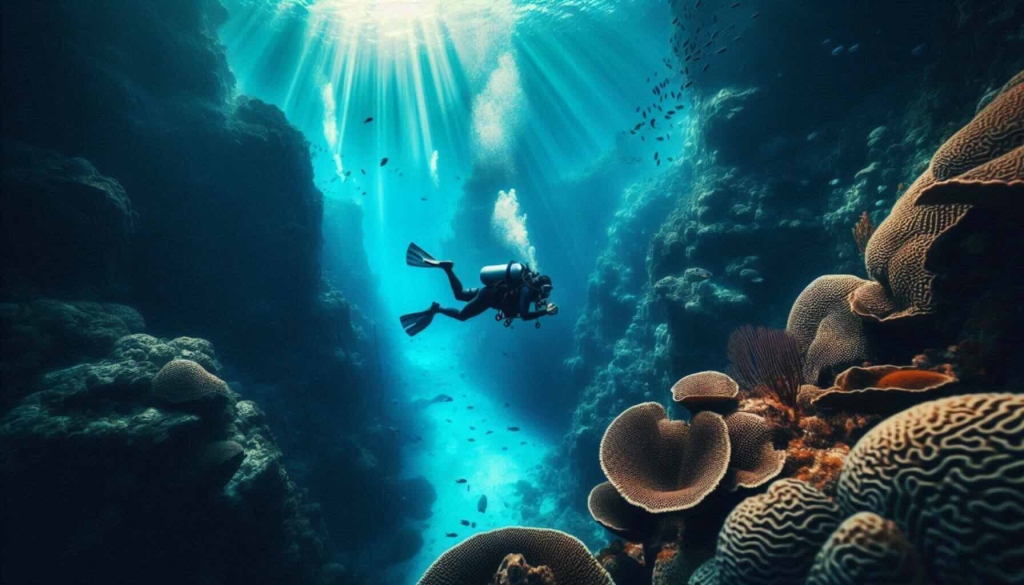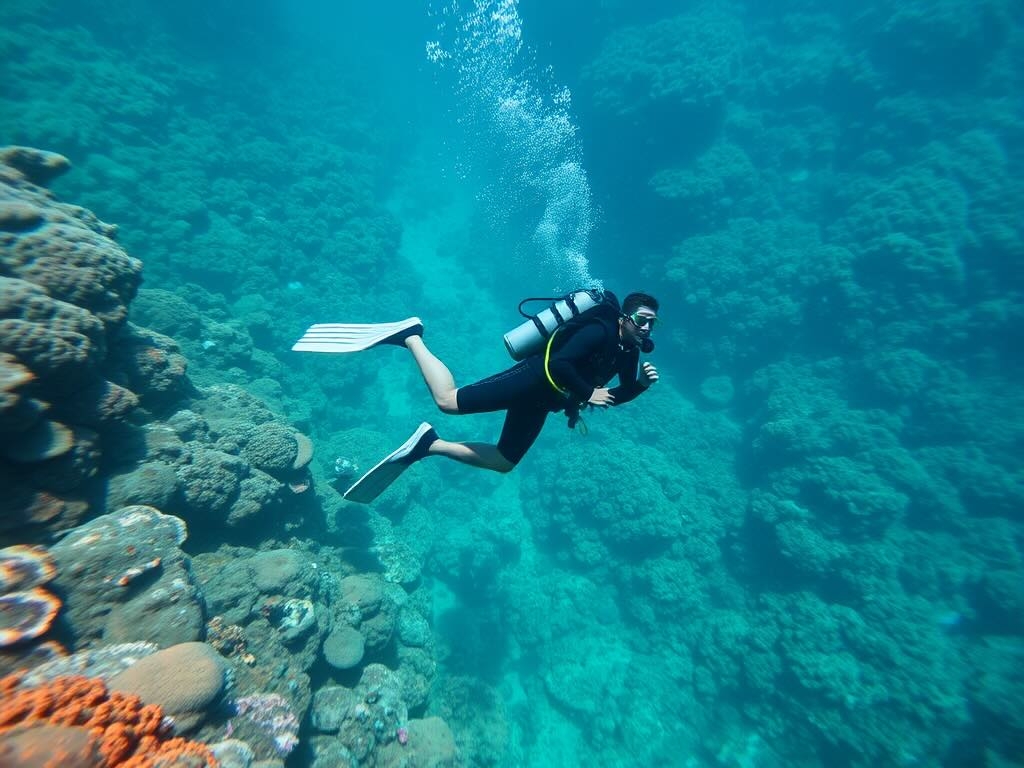The Great Blue Hole Dive: What to Actually Expect
A guide to Belize's Great Blue Hole. The best time to dive, preparation tips, and more.
Imagine floating above a giant, round hole in the sea. Its deep blue waters call you to explore. This is the Great Blue Hole, one of the world's best dive spots! It's off the coast of Belize, and divers love it. Let's find out what makes this underwater wonder so special.

What's the Great Blue Hole?
The Great Blue Hole is a huge underwater sinkhole. It's in the Lighthouse Reef, about 43 miles from Belize. This natural wonder is almost a perfect circle. It's about 1,000 feet wide and over 400 feet deep. It's so big you can see it from space!
Fun fact: The Great Blue Hole formed during the last ice age. Back then, sea levels were much lower. As the ocean rose, it filled the cavern. That's how we got the amazing blue hole we see today.
The Story Behind the Blue Hole
The Great Blue Hole has a cool history. Here's how it formed:
First, it was a cave. Rain carved it out of limestone long ago.
Then, the cave's roof fell in. This made a big, round hole.
Finally, the sea level rose. Water filled the hole, making the blue wonder we see now.
The hole looks so blue because of how deep it is. The deep water looks dark blue next to the lighter reef around it. It's like nature decided to paint a giant blue bullseye in the ocean!
Why Dive the Great Blue Hole?
Diving here is like entering another world. Here's why divers love it:
Cool Rock Shapes: As you go down, you'll see amazing limestone formations. There are huge stalactites and stalagmites. Some are as long as a school bus!
Clear Water: You can often see very far in the Blue Hole. On a good day, you might see up to 200 feet ahead!
Sea Life: While there aren't many fish in the hole itself, the reef around it is full of life. You might see sharks, colorful fish, and maybe even giant groupers.
Unique Experience: The Blue Hole looks like no other place on Earth. As you go deeper, the light changes in cool ways. It feels almost like being on another planet.
Bragging Rights: Not many people have dived the Blue Hole. It's something to be proud of!

Getting Ready to Dive
Diving the Great Blue Hole isn't your average day out on the reef. Here's what you need to know before taking the plunge:
Who Can Dive?
Experience level is required! The Blue Hole dive is for skilled divers. Most dive shops want you to have:
Advanced Open Water certification (or equivalent)
At least 24 logged dives
Experience with deep dives (30+ meters)
Comfort with potential strong currents
Don't worry if you're not there yet. Many places offer training dives to help you get ready.
What to Bring
While most dive operators provide equipment, here's what you'll need:
A dive computer that works at 130 feet (at least 40 meters) or deeper
A dive light (for exploring the cavern)
A wetsuit (water temperatures can be cool at depth)
A backup air source (pony bottle or extended air system)
Underwater camera (trust us, you'll want to capture this)
Physical Fitness
The dive can be physically demanding. Make sure you're in good health and feel comfortable with deep diving before attempting the Blue Hole. It's a good idea to:
See a doctor before your trip
Practice controlling your buoyancy
Work on underwater hand signals
Drink lots of water and get good sleep before the dive
What It's Really Like
Here's what you'll see as you dive the Blue Hole:
The Drop: As you go in, you'll see why it's called the Blue Hole. The water is so blue and clear!
The Wall: About 30-40 feet down, you'll reach the hole's wall. It's covered in colorful sponges and corals.
The Cave: At about 110-130 feet, you'll see the cave area. This is where the huge stalactites are. They hang from the ceiling like stone icicles.
The Deep Zone: As you go deeper, you might feel a bit odd. This is called nitrogen narcosis. It can make you feel dizzy or happy. Stay alert and keep in touch with your dive buddy.
Sea Life: Look out for sharks, big fish, and other sea creatures. You might see more in the deeper water.

The Way Up: As you come back up, watch how the colors change. It's like seeing the ocean wake up as you rise.
Always follow your guide and don't push past your limits. Safety first!
Best Time to Dive the Blue Hole
While diving is possible year-round, the best time to visit is during the dry season, from February to May. During these months, you can expect:
Calmer seas
Better visibility (often exceeding 100 feet)
Warmer water (about 78-82°F)
However, keep in mind that this is also peak tourist season, so book your dive trip well in advance!
The rainy season (June to December) can offer some benefits too:
Fewer people
More sea life to see
Lower prices on accommodations and dive packages
Just be ready for rougher seas and water that's not as clear.
Beyond the Blue Hole: Other Diving Opportunities
The Blue Hole is amazing, but don't miss these other great spots:
Half Moon Caye Wall: See beautiful corals and lots of fish. Look for rays and maybe even hammerhead sharks!
The Aquarium: This is a shallow dive with tons of colorful fish. Great for photos and night dives.
Long Caye Wall: See big drop-offs and maybe some large ocean fish. The wall is covered in black coral and big sponges.
Quebrada: Swim through underwater tunnels and caves. Great for practicing your buoyancy control.
Many dive trips include the Blue Hole and some of these sites. It's a great way to see all that Belize diving has to offer.
Diving Responsibly
The Great Blue Hole is a fragile ecosystem. As divers, we have a responsibility to protect it. Here are some tips for responsible diving:
Don't touch or remove anything from the site
Be aware of your buoyancy to avoid damaging coral
Use reef-safe sunscreen
Support local conservation efforts
Report any signs of damage or pollution to your dive operator
Remember, we're guests in this underwater world. Let's make sure we leave it as pristine as we found it for future generations of divers to enjoy.

Practical Tips for Your Blue Hole Scuba Diving
Planning a trip to dive the Blue Hole? Here are some practical tips to make your experience smoother:
1. Book in Advance: Popular dive operators fill up quickly, especially during peak season.
2. Get Travel Insurance: Make sure it covers scuba diving activities.
3. Arrive Early: Plan to arrive in Belize at least a day before your dive to acclimatize and deal with any potential travel delays.
4. Stay Hydrated: The tropical climate can be dehydrating, which isn't great for diving. Drink plenty of water.
5. Bring Motion Sickness Medication: The boat ride to the Blue Hole can be rough. Better safe than sorry!
6. Pack Light: Most of your time will be spent in dive gear or swimwear. Don't overpack.
7. Bring a Logbook: You'll want to document this epic dive.
Why the Blue Hole Matters
The Blue Hole isn't just cool to look at. It's important to Belize. It's on their tourism logo and makes people proud. Scientists study it too. In 1971, Jacques Cousteau, a famous ocean explorer, said it was one of the best dive sites in the world.
In 2018, Richard Branson and Fabien Cousteau (Jacques' grandson) led a big trip to map the whole Blue Hole. They found some trash at the bottom. This shows we need to take better care of our oceans, even in remote places.
Wrap-Up
Diving the Great Blue Hole is a once-in-a-lifetime adventure. It's a journey through time, a test of your dive skills, and a chance to see one of nature's most amazing creations up close.
So gear up and jump in! The Great Blue Hole is waiting to show you its secrets. You'll come back with great memories and maybe a new love for our oceans. Happy diving!
FAQ
How deep is the Great Blue Hole?
The Great Blue Hole reaches depths of over 400 feet (122 meters). However, recreational divers typically don't go beyond 130-140 feet due to safety considerations.
Is it safe to dive the Great Blue Hole?
While the Blue Hole dive is considered advanced, it can be safe when proper precautions are taken. Always dive with a reputable operator and within your skill level.
Can beginners dive the Great Blue Hole?
The Blue Hole dive is not recommended for beginners due to its depth and the skills required. Most operators require Advanced Open Water certification and significant diving experience.
What fish can I see in the Great Blue Hole?
While the hole itself isn't rich in marine life, you might encounter Caribbean reef sharks, midnight parrotfish, and other pelagic species. The surrounding reef areas are teeming with tropical fish and coral.
How much does it cost to dive the Great Blue Hole?
Prices vary, but you can expect to pay between $200-$300 USD for a day trip that includes the Blue Hole dive and additional dives in the area. This typically includes gear rental, lunch, and park fees.
Do I need special equipment to dive the Blue Hole?
While most equipment is standard, you'll need a dive computer rated for the depth and a dive light for exploring the cavern zone. Many operators provide these if you don't have your own.
Is the Great Blue Hole really blue?
Yes! The Blue Hole gets its striking blue color from the contrast between the shallow reef surrounding it and the deep blue of the hole itself. This effect is particularly striking from the air.

I'm a scuba enthusiast, and marine life lover. I enjoy writing about my diving adventures and sharing my knowledge with others.

I'm a passionate scuba diver and love to share my experiences with you. I enjoy writing about my experiences and sharing my knowledge with others.